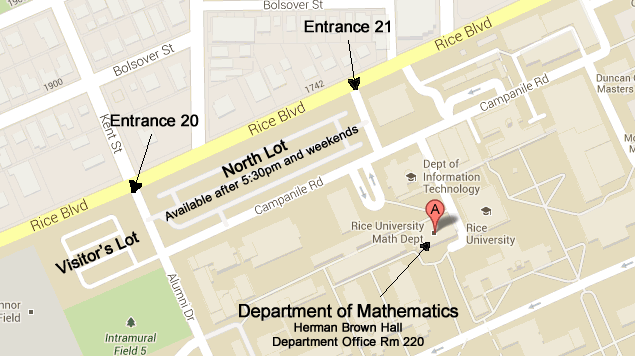Welcome to a timeline of our Department. We have a great deal of material so much of the information is contained in the webpages linked on the left-hand side.
1912-1921: Founding of Rice Institute and the Early Years of the Department
Mathematics was one of the original departments dating from the Rice Institute's first academic year in 1912 Of the 9 faculty listed in the 1912-13 Rice Institute General Announcements, 3 were mathematicians: Percy John Daniell, Griffith Conrad Evans and Edgar Odell Lovett, also the Institute's 1st President. Through Lovett's recruiting skills they were joined a short time later by William Casper Graustein (1914), Francis D. Murnaghan (1916) and Hubert E. Bray (1918). A handwritten memo about the founding and early years of the department written by Hubert Bray gives a personal perspective on the personalities and histories of the initial faculty members.
Although there were no special facilities or classes, women were admitted to Rice if they met the entrance requirements. One of the earliest female graduates was Alice Crowell Dean who graduated with a master's degree in Mathematics and became an Instructor in 1921. She would continue to teach the famously demanding "Math 100" course, as well as overseeing the Institute's Library, until her retirement in 1946.
1930-1945: Depression and War Years
After hiring Lester Ford (later President of the Mathematical Association of America) in 1920, a combination of inflation of the 20's and depression in the 30's slowed Rice's growth and the department's next faculty member was not hired until almost 20 years later. Floyd Ulrich started as an instructor in 1938, became a professor in 1946, and stayed until his retirement in 1972.
Szolem Mandelbrojt first came to Rice as a guest lecturer in 1926. The rising tide of anti-Semitism in Europe brought his return - at first with the title "visiting professor" in 1941 then as a full faculty member in 1946. Although he returned to the College de France after the War, he would continue to publish his professional papers through the Rice Institute.
1950-1960: Post War Boom
The war years were lean - Rice's General Announcements were not published from 1943-1946. But after WWII, along with the rest of the country, Rice's endowment grew and allowed almost a doubling of the number of faculty. The department added 8 new faculty members between 1947-1960.
In 1958 the return of Rice Alum Jim Douglas, Jr. (PhD Mathematics, 1952) marked the entry of the department (and Rice) into the world of high speed computing. His research focused on numerical procedures which allow complicated differential equations to be analyzed faster by computers.
1960-1970: We're a University now
Pursuing Lovett's idea of becoming more than simply a technical school, in 1960 the "Rice Institute" officially became "Rice University". Also aligned with Lovett's vision of a university, Rice's 3rd President, Kenneth Pitzer, arrived in 1961 with the ambition of taking Rice from a well-regarded regional institute to a nationally respected university. To this end Rice's student and faculty numbers increased dramatically in the 60's.
Salomon Bochner joined the department in 1968 and, as well as teaching classes and doing research, he also founded Scientia, an interdisciplinary institute for the discussion of ideas spanning the humanities and sciences. In a department which was heavily involved in the area of analysis, F. Reese Harvey's arrival (also in 1968) would expand the department research into differential geometry and Harvey would go on to introduce the theory of "calibrated geometries".
1970-1980: Financial Consolidation and Diversification
After the boom years of the 60's, the term of Norman Hackerman (Rice's 4th President) was noted for its fiscal conservatism. Although the number of new faculty hired decreased, the department continued to diversify its research interests, notably into algebra and topology.
The growing importance of the computer was highlighted by the arrival of Mary Wheeler in 1973. She had received her PhD in Mathematics from Rice in 1971 and would go on to become a member of the National Academy of Engineering for her work in developing numerical methods for partial differential equations.
1980-1995: New Buildings and renewed Growth
The end of President Hackerman's tenure and the inauguration of George Rupp as Rice's 5th President brought a renewed emphasis on the quality of Rice's undergrad and graduate experience. The campaign would be two-fold: construction of state-of- the-art teaching facilities and the expansion of the curriculum into new interdisciplinary courses. During this time new faculty expanded the department's research interests to include combinatorics, ergodic theory and mathematical physics.
Hired in 1981, young faculty member Robert Bryant began research in differential geometry and his efforts would result in significant contributions in exterior differential systems, exceptional holonomy, and Finsler geometry.
1995-present: Moving Forward and Looking Back
Rice's centennial gives us an opportunity to see how the department has changed. It started with 3 faculty members (1 Professor and 2 Assistant Professors) and now has 14 faculty members and 9 C.G. Evans/VIGRE Instructors. In 1914 the students had a choice of 10 classes in pure and applied mathematics; the 2010-11 General Announcements lists 60. The early research emphasis on analysis and potential theory has expanded to include 11 separate areas of research. (See our webpage for more details). As well as providing "service courses" for majors in other fields such as economics, geology and pre-med, we have graduated 247 PhD's in Mathematics since 1950.
The department has been a central part of the University since its inception; after all Rice's first PhD was awarded in Mathematics in 1918 - to Hubert Bray.
The timeline used here is heavily borrowed from John Boles, "A university so conceived: A brief history of Rice", Revised 1997. A special thanks to Debra Kolah, Amanda Focke and the staff of the Woodson center for their research expertise and help to put together this brief history

